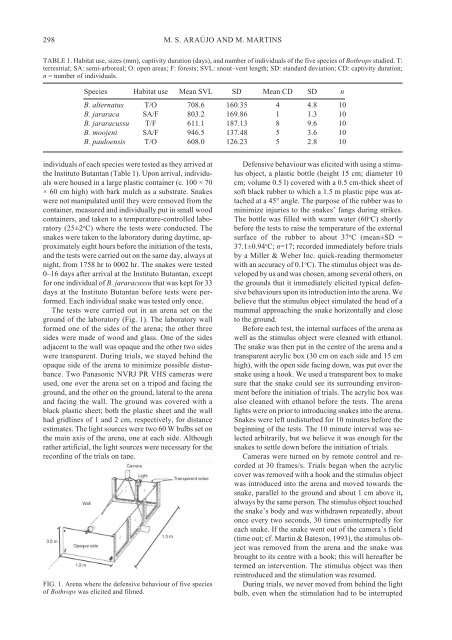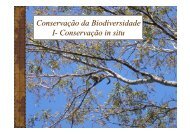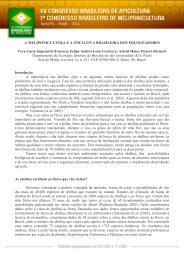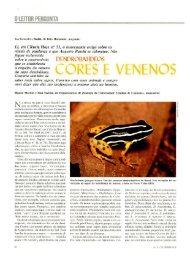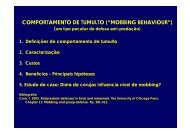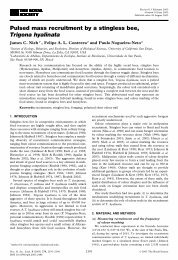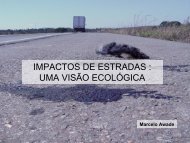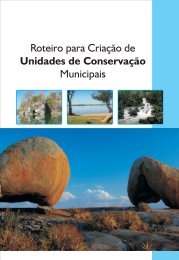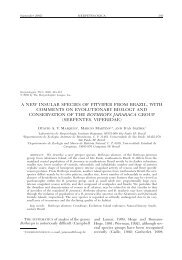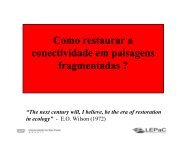Araujo & Martins pp 297-303.pmd - Ecologia
Araujo & Martins pp 297-303.pmd - Ecologia
Araujo & Martins pp 297-303.pmd - Ecologia
You also want an ePaper? Increase the reach of your titles
YUMPU automatically turns print PDFs into web optimized ePapers that Google loves.
298<br />
M. S. ARAÚJO AND M. MARTINS<br />
TABLE 1. Habitat use, sizes (mm), captivity duration (days), and number of individuals of the five species of Bothrops studied. T:<br />
terrestrial; SA: semi-arboreal; O: open areas; F: forests; SVL: snout–vent length; SD: standard deviation; CD: captivity duration;<br />
n = number of individuals.<br />
Species Habitat use Mean SVL SD Mean CD SD n<br />
B. alternatus T/O 708.6 160.35 4 4.8 10<br />
B. jararaca SA/F 803.2 169.86 1 1.3 10<br />
B. jararacussu T/F 611.1 187.13 8 9.6 10<br />
B. moojeni SA/F 946.5 137.48 5 3.6 10<br />
B. pauloensis T/O 608.0 126.23 5 2.8 10<br />
individuals of each species were tested as they arrived at<br />
the Instituto Butantan (Table 1). Upon arrival, individuals<br />
were housed in a large plastic container (c. 100 × 70<br />
× 60 cm high) with bark mulch as a substrate. Snakes<br />
were not manipulated until they were removed from the<br />
container, measured and individually put in small wood<br />
containers, and taken to a temperature-controlled laboratory<br />
(25±2 o C) where the tests were conducted. The<br />
snakes were taken to the laboratory during daytime, a<strong>pp</strong>roximately<br />
eight hours before the initiation of the tests,<br />
and the tests were carried out on the same day, always at<br />
night, from 1758 hr to 0002 hr. The snakes were tested<br />
0–16 days after arrival at the Instituto Butantan, except<br />
for one individual of B. jararacussu that was kept for 33<br />
days at the Instituto Butantan before tests were performed.<br />
Each individual snake was tested only once.<br />
The tests were carried out in an arena set on the<br />
ground of the laboratory (Fig. 1). The laboratory wall<br />
formed one of the sides of the arena; the other three<br />
sides were made of wood and glass. One of the sides<br />
adjacent to the wall was opaque and the other two sides<br />
were transparent. During trials, we stayed behind the<br />
opaque side of the arena to minimize possible disturbance.<br />
Two Panasonic NVRJ PR VHS cameras were<br />
used, one over the arena set on a tripod and facing the<br />
ground, and the other on the ground, lateral to the arena<br />
and facing the wall. The ground was covered with a<br />
black plastic sheet; both the plastic sheet and the wall<br />
had gridlines of 1 and 2 cm, respectively, for distance<br />
estimates. The light sources were two 60 W bulbs set on<br />
the main axis of the arena, one at each side. Although<br />
rather artificial, the light sources were necessary for the<br />
recording of the trials on tape.<br />
FIG. 1. Arena where the defensive behaviour of five species<br />
of Bothrops was elicited and filmed.<br />
Defensive behaviour was elicited with using a stimulus<br />
object, a plastic bottle (height 15 cm; diameter 10<br />
cm; volume 0.5 l) covered with a 0.5 cm-thick sheet of<br />
soft black rubber to which a 1.5 m plastic pipe was attached<br />
at a 45° angle. The purpose of the rubber was to<br />
minimize injuries to the snakes’ fangs during strikes.<br />
The bottle was filled with warm water (60 o C) shortly<br />
before the tests to raise the temperature of the external<br />
surface of the rubber to about 37 o C (mean±SD =<br />
37.1±0.94 o C; n=17; recorded immediately before trials<br />
by a Miller & Weber Inc. quick-reading thermometer<br />
with an accuracy of 0.1 o C). The stimulus object was developed<br />
by us and was chosen, among several others, on<br />
the grounds that it immediately elicited typical defensive<br />
behaviours upon its introduction into the arena. We<br />
believe that the stimulus object simulated the head of a<br />
mammal a<strong>pp</strong>roaching the snake horizontally and close<br />
to the ground.<br />
Before each test, the internal surfaces of the arena as<br />
well as the stimulus object were cleaned with ethanol.<br />
The snake was then put in the centre of the arena and a<br />
transparent acrylic box (30 cm on each side and 15 cm<br />
high), with the open side facing down, was put over the<br />
snake using a hook. We used a transparent box to make<br />
sure that the snake could see its surrounding environment<br />
before the initiation of trials. The acrylic box was<br />
also cleaned with ethanol before the tests. The arena<br />
lights were on prior to introducing snakes into the arena.<br />
Snakes were left undisturbed for 10 minutes before the<br />
beginning of the tests. The 10 minute interval was selected<br />
arbitrarily, but we believe it was enough for the<br />
snakes to settle down before the initiation of trials.<br />
Cameras were turned on by remote control and recorded<br />
at 30 frames/s. Trials began when the acrylic<br />
cover was removed with a hook and the stimulus object<br />
was introduced into the arena and moved towards the<br />
snake, parallel to the ground and about 1 cm above it,<br />
always by the same person. The stimulus object touched<br />
the snake’s body and was withdrawn repeatedly, about<br />
once every two seconds, 30 times uninterruptedly for<br />
each snake. If the snake went out of the camera’s field<br />
(time out; cf. Martin & Bateson, 1993), the stimulus object<br />
was removed from the arena and the snake was<br />
brought to its centre with a hook; this will hereafter be<br />
termed an intervention. The stimulus object was then<br />
reintroduced and the stimulation was resumed.<br />
During trials, we never moved from behind the light<br />
bulb, even when the stimulation had to be interrupted


